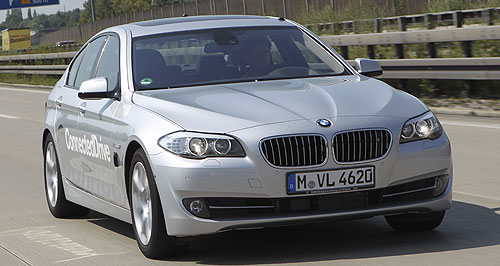News - BMWBMW develops self-driving 5 Series prototypeSack the chauffeur: BMW is developing a system based on existing sat-nav, cruise control and safety technology to create the self-driving car of the future. Convenience and safety technologies combine in 'highly automated' BMW 5 Series31 Aug 2011 SCIENCE fiction has taken another step closer to becoming science fact with BMW's technology packed, self-driving 5 Series prototype. The emergence of advancements such as radar-based adaptive cruise control, lane-keeping, road-sign recognition, automated parking, collision-avoidance and crash mitigation technology in recent years have all pointed to the fact that with the aid of satellite navigation, cars will soon have the decision-making power to take over from human drivers, or at least act as co-pilot. BMW has taken this to the ultimate conclusion with its Highly Automated Driving technology, which at speeds of up to 130km/h, “brakes, accelerates and passes other vehicles on its own, while also monitoring and adapting to the prevailing traffic conditions”. The Munich-based luxury brand says one of the project's biggest challenges was to get the car to react properly to other vehicles merging into traffic from motorway on-ramps, but that this was overcome by programming the system to allow merging vehicles to join the traffic flow – even changing lanes to give them space – unlike the stereotypical human BMW driver. Designed to work on motorways at the push of a button, the system uses existing technology such as lane departure warning and adaptive cruise control, comprises multiple sensor types including laser, radar, ultrasound and video cameras to give it 360-degree awareness of the car's position in its lane and in relation to surrounding objects and can comply with traffic regulations such as speed limits and no-overtaking zones.  Data gathered from the many sensors – which BMW says combine to precisely assess the vehicle situation and ensure that a potential weakness in each method is counterbalanced by strengths of the others – is used in conjunction with “extremely precise” GPS and digital maps to inform the car of its lane position, characteristics of the road ahead the number of lanes each section of road has. Data gathered from the many sensors – which BMW says combine to precisely assess the vehicle situation and ensure that a potential weakness in each method is counterbalanced by strengths of the others – is used in conjunction with “extremely precise” GPS and digital maps to inform the car of its lane position, characteristics of the road ahead the number of lanes each section of road has.The development team have covered almost 5000 kilometres of testing. Project manager of highly automated driving for BMW Group Research and Technlogy Dr. Nico Kämpchen said handing over complete control of the car is a “strange feeling”. “But after a few minutes of experiencing the smooth, sovereign and safe driving style, drivers and passengers begin to relax somewhat and trust the independent system.” The Bavarian carmaker's i3 ecocity-car concept also features a version of the technology tailored to make driving in its intended city environment less stressful by taking over the controls in congested traffic at speeds of up to 40km/h – provided the driver keeps one hand on the steering wheel – maintaining a safe distance between vehicles, adjusting the vehicle's speed and steering plus coming to a complete stop if required. A technology previously developed by BMW called Emergency Stop Assistant was a precursor to the fully-automated car and would take control of the car to bring it safely to a stop if the driver lost control, for example, if they passed out at the wheel. The in-car telematics would then automatically send out an emergency call to inform authorities of the situation. Another example of the self-driving technology is BMW's Track Trainer, which in 2007 was demonstrated on the UK's Top Gear test track with Jeremy Clarkson in the driver's seat of a 330i sedan as it took him on a self-guided hot lap. BMW also used the system in 2009 – which is now in its second generation and used in driver training sessions to give students a “genuine feel for the racing line” from the driver's seat – on the famed Nurburgring and again in May this year at the Laguna Seca circuit in California. Dr. Kämpchen said: “The main difference between the sessions at the race track and trials on the motorway is that we are not alone when driving along a public motorway. “That is why we were interested in learning about the developments in the Emergency Stop Assistant Project to ensure safety in our own undertaking.” For now, development of the 5 Series prototype is ongoing. “The next thing we want to ‘teach’ our prototype is how to deal with road construction sites and motorway junctions, said Dr. Kämpchen. “Construction sites are a big challenge because they take on all kinds of forms, which makes detection, localisation and determining the right vehicle response quite difficult.” Swedish brand Volvo is developing its own type of self-driving technology, in which cars are platooned into a convoy or 'road train' behind a lead vehicle – probably a truck – that is driven by a professional driver going in the desired direction. Benefits of the Volvo system are that drivers in the platoon do not have to keep their eyes on the road or be in any other way involved with the driving process until they wish to leave the convoy. Because the vehicles follow each other closely, there are also fuel efficiency benefits from slipstreaming.  Read more |
Click to shareBMW articlesResearch BMW Motor industry news |
















Facebook Twitter Instagram